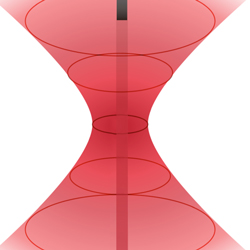Phase Transitions in Non-Hermitian Physics
Submission Deadline: January 31, 2026Contribute to this Special Topic
 While until recently Hermiticity has been a key aspect of pure quantum mechanics, now experimental advances in controlling dissipation yielded the ability to create designer materials that can be described by non-Hermitian Hamiltonians in open classical and quantum systems. Most prominent examples are parity-time-symmetric optical systems with gain and loss, random systems in non-conserving environments, dissipative Bose-Einstein condensates, dissipative exciton-polariton systems, and also biological networks. Exceptional degeneracies, non-Hermitian skin modes, disorder-driven localization, Floquet-engineered bands and measurement-induced entanglement transitions can now be created and tuned in photonic lattices, acoustic and mechanical metamaterials, magnon and exciton-polariton condensates, as well as in gate-based quantum processors with tens of qubits. This Special Topic will showcase how such platforms sharpen the notion of phase transitions far from Hermitian equilibrium and open routes toward functional devices and quantum technologies. We welcome research work that explores static, dynamical, and topological phase transitions arising from non-Hermiticity.
While until recently Hermiticity has been a key aspect of pure quantum mechanics, now experimental advances in controlling dissipation yielded the ability to create designer materials that can be described by non-Hermitian Hamiltonians in open classical and quantum systems. Most prominent examples are parity-time-symmetric optical systems with gain and loss, random systems in non-conserving environments, dissipative Bose-Einstein condensates, dissipative exciton-polariton systems, and also biological networks. Exceptional degeneracies, non-Hermitian skin modes, disorder-driven localization, Floquet-engineered bands and measurement-induced entanglement transitions can now be created and tuned in photonic lattices, acoustic and mechanical metamaterials, magnon and exciton-polariton condensates, as well as in gate-based quantum processors with tens of qubits. This Special Topic will showcase how such platforms sharpen the notion of phase transitions far from Hermitian equilibrium and open routes toward functional devices and quantum technologies. We welcome research work that explores static, dynamical, and topological phase transitions arising from non-Hermiticity.
Topics covered include, but are not limited to:
- Topological phases and exceptional structures – higher-order EPs, exceptional lines/surfaces, Weyl exceptional rings and generalized bulk–edge correspondences
- Non-Hermitian skin effects & generalized Brillouin-zone theory — criteria, classification and experimental realizations
- Finite lifetimes and non-Hermitian quasiparticles — polaritons, magnons, plasmons and other modes with interaction-induced decay
- Disorder-driven and Anderson-type transitions in open or gain–loss media
- Random systems, random walks and biological or graph analogues of non-Hermitian criticality
- Lasing, coherent perfect absorption and topological amplification in electronic, photonic, phononic and acoustic metamaterials
- Non-reciprocal and chiral transport phenomena; quantum-thermodynamic aspects, entropy production and speed limits
- Floquet-engineered phases and time-crystalline behavior in driven platforms
- Dynamical criticality and scaling in driven non-Hermitian matter, quenches and ramps in spin chains, photonic/phononic lattices and other open systems
- Non-unitary dynamics and measurement-induced phase transitions in quantum processors, superconducting and spin-qubit devices, trapped-ion and photonic processors, NMR simulators
Guest Editors
Regine Frank – Larkin University, USA
Dario Bercioux – DIPC – Donostia International Physics Center, Spain
Peng Xue – Beijing Computational Science Research Center, China
Roberta Citro – University of Salerno, Italy
Submission Deadline: January 31, 2026Contribute to this Special Topic
